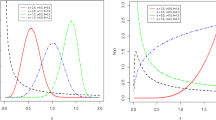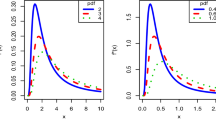Abstract
The role of the selection operation—that stochastically discriminate between individuals based on their merit—on the updating of the probability model in univariate estimation of distribution algorithms is investigated. Necessary conditions for an operator to model selection in such a way that it can be used directly for updating the probability model are postulated. A family of such operators that generalize current model updating mechanisms is proposed. A thorough theoretical analysis of these operators is presented, including a study on operator equivalence. A comprehensive set of examples is provided aiming at illustrating key concepts, main results, and their relevance.











Similar content being viewed by others
Notes
Several software packages include efficient ways of computing the normal cdf.
References
Baluja S (1994) Population-based incremental learning: a method for integrating genetic search based function optimization and competitive learning. Technical report CMU-CS-94-13. Carnegie Mellon University, Pittsburgh, Pennsylvania, USA
Baluja S, Davies S (1997) Using optimal dependency-trees for combinatorial optimization: learning the structure of the search space. In: Proceedings of the 14-th International Conference on Machine Learning. San Francisco, California, USA, pp 30–38
Bengoetxea E, Larrañaga P, Bloch I, Perchant A, Boeres C (2002) Inexact graph matching by means of estimation of distribution algorithms. Pattern Recognit 35(12):2867–2880
Ceberio J, Irurozki E, Mendiburu A, Lozano JA (2012) A review on estimation of distribution algorithms in permutation-based combinatorial optimization problems. Prog AI 1(1):103–117
De Bonet JS, Isbell CL, Viola P (1997) MIMIC: finding optima by estimating probability densities. In: Petsche T, Mozer MC, Jordan MI (eds) Advances in neural information processing systems. MIT Press, Cambridge, pp 424–430
Droste S (2006) A rigorous analysis of the compact genetic algorithm for linear functions. Nat Comput 5:257–283
Echegoyen C, Mendiburu A, Santana R, Lozano JA (2013) On the taxonomy of optimization problems under estimation of distribution algorithms. Evolut Comput 21(3):471–495
Emmendorfer LR, Pozo AT (2009) Effective linkage learning using low-order statistics and clustering. IEEE Trans Evolut Comput 13(6):1233–1246
González C, Lozano JA, Larrañaga P (2001) Analyzing the PBIL algorithm by means of discrete dynamical systems. Complex Syst 12(4):465–479
Harik GR (1999) Linkage learning via probabilistic modeling in the ECGA. Technical report 99010. Illinois Genetic Algorithms Laboratory, University of Illinois, Urbana, Illinois, USA
Harik GR, Lobo FG, Goldberg DE (1999) The compact genetic algorithm. IEEE Trans Evolut Comput 3(4):287–297
Hauschild M, Pelikan M (2011) An introduction and survey of estimation of distribution algorithms. Swarm Evolut Comput 1:111–128
Johnson A, Shapiro JL (2002) The importance of selection mechanisms in distribution estimation algorithms. In: Collet P, Fonlupt C, Hao JK, Lutton E, Schoenauer M (ed) Evolution artificial, vol 2310. Lecture Notes in Computer Science, Springer, pp 91–103
Larrañaga P, Lozano JA (2001) Estimation of distribution algorithms: a new tool for evolutionary computation. Kluwer Academic Publishers, Norwell
Lozada-Chang L, Santana R (2011) Univariate marginal distribution algorithm dynamics for a class of parametric functions with unitation constraints. Inf Sci 181(11):2340–2355
Mühlenbein H (1997) The equation for response to selection and its use for prediction. Evolut Comput 5:303–346
Mühlenbein H, Mahnig T (1998) Convergence theory and applications of the factorized distribution algorithm. J Comput Inf Technol 7:19–32
Mühlenbein H, Mahnig T (2002) Evolutionary algorithms and the Boltzmann distribution. In: DeJong KA, Poli R, Rowe J (eds) Foundation of genetic algorithms 7. Morgan Kaufmann, Burlington, pp 133–150
Mühlenbein H, Mahnig T, Rodriguez AO (1999) Schemata, distributions and graphical models in evolutionary optimization. J Heuristics 5:215–247
Pelikan M, Goldberg DE (2000) Genetic algorithms, clustering, and the breaking of symmetry. Lecture Notes in Computer Science 1917, pp 385–394
Pelikan M, Goldberg DE (2001) Escaping hierarchical traps with competent genetic algorithms. In: Genetic and Evolutionary Computation Conference, pp 511–518
Pelikan M, Goldberg DE, Cantu-Paz E (2000) Linkage problem, distribution estimation, and Bayesian networks. Evolut Comput 8:311–340
Pelikan M, Mühlenbein H (1999) The bivariate marginal distribution algorithm. In: Chawdhry PK, Roy R, Furuhashi T (eds) Advances in soft computing—engineering design and manufacturing. Springer, Berlin, pp 521–535
Peña J, Lozano J, Larrañaga P (2005) Globally multimodal problem optimization via an estimation of distribution algorithm based on unsupervised learning of Bayesian networks. Evolut Comput 13(1):43–66
Sastry K, Goldberg DE (2001) Modeling tournament selection with replacement using apparent added noise. In: Proceedings of the Genetic and Evolutionary Computation Conference (GECCO-2001). San Francisco, California, USA, p 781
Zhang Q (2004a) On stability of fixed points of limit models of univariate marginal distribution algorithm and factorized distribution algorithm. IEEE Trans Evolut Comput 8(1):80–93
Zhang Q (2004b) On the convergence of a factorized distribution algorithm with truncation selection. Complexity 9(4):17–23
Zhang Q, Mühlenbein H (2004) On the convergence of a class of estimation of distribution algorithms. IEEE Trans Evolut Comput 8(2):127–136
Acknowledgments
Andrey Bronevich is grateful to the Erasmus Mundus Triple I Consortium that supported a 10-months academic visit to the University of Algarve in 2010. This work is an outcome of a research cooperation between the authors that began with this visit. Andrey Bronevich also thanks the National Research University Higher School of Economics, Moscow, Russia for providing him with 1 month research grant for visiting University of Algarve in July 2014 facilitating the conclusion of the work. José Valente de Oliveira also thanks the National Research University Higher School of Economics, for inviting him for one week visit in November 2014.
Author information
Authors and Affiliations
Corresponding author
Appendix
Appendix
Proof of Theorem 1
Under conditions (a)–(e) function \(\gamma _1 \) is differentiable in \(( - \infty ,0]\) and its convexity implies that
is increasing in \(( - \infty ,0]\). This is obviously equivalent to have \(F(x) = \frac{{\varphi '(x)x}}{{\varphi (x)}}\) as an increasing function in \((0,1]\). Solving this differential equation w.r.t. \(\varphi \) we see that the function \(\varphi \) can be expressed as \(\varphi (x) = Cx^a e^{\int \limits _0^x {\frac{{F_0 (y)}}{y}} dy} \), where an arbitrary constant \(C\) should be chosen such that \(\varphi (1) = 1\), i.e., \(C = e^{ - \int \limits _0^1 {\frac{{F_0 (y)}}{y}} dy} \).
Let us show that the value \(a \geqslant 1\)(clearly \(a > 0\) in order to have \(\varphi (0) = 0)\). Denote \(\varphi _0 (x) = Ce^{\int \limits _0^x {\frac{{F_0 (y)}}{y}} dy} \). Then
Therefore, if \(a - 1 < 0\) then \(\varphi ''(x) < 0\) for some values that are close to 0, since \(\mathop {\lim }\limits _{x \rightarrow + 0} \left( {{{\frac{{F_0 (x)}}{x}} / {\frac{{a - 1}}{x}}}} \right) = 0\). This means that \(a \geqslant 1\).
For the second part of the theorem, if we choose the function \(F_0 \) as stated by the theorem, then conditions (a)–(c), and (e) are obviously satisfied. It remains to show that (d) is also satisfied. Function \(\gamma _2 (y) = \ln \left( {1 - \varphi \left( {1 - e^y } \right) } \right) \) is differentiable and the function
should be decreasing. This is equivalent to
be an increasing function. Substituting \(\varphi (x) = x^a \varphi _0 (x)\), \(\varphi '(x) = x^{a - 1} \varphi _0 (x)\left( {F_0 (x) + a} \right) \), we get
Then
Notice that
Therefore,
Because \(\varphi _0 (x) \leqslant 1\) and \(F_0 (x) \geqslant 0\), \({{F'_0 (x)} / {\left( {F_0 (x) + a} \right) }} \geqslant 0\), we get
We see that
where the inequality \(x^a + a(1 - x) - 1 \geqslant 0\) for \(a \geqslant 1\) and \(x \in [0,1]\) is proved as in Example 3, i.e., \(g'(x) \geqslant 0\) and the condition d) is also fulfilled. \(\square \)
Proof of Proposition 3
We will use the notation from Theorem 1. Computing the function \(g\) for this case, we get
Let us compute the limit \(b = \mathop {\lim }\limits _{x \rightarrow + 0} g(x)\), involving a new variable \(y = \varPhi ^{ - 1} (x)\):
Obviously, \(b = 1\) for \(\beta = 1\). Applying the L’Hospital rule for the general case, one can obtain that \(b = \beta ^2 \), i.e., we conclude that \(\beta \geqslant 1\).
Let us check now when \(g\) is an increasing function. This condition is equivalent to the non-negativity of the derivative
for any \(y \in ( - \infty , + \infty )\). Making simple calculations, we get
Notice that \(\mathop {\lim }\limits _{y \rightarrow + \infty } f(y) = - \infty \) for \(\beta > 1\) and \(\mathop {\lim }\limits _{y \rightarrow + \infty } f(y) = - \alpha \) for \(\beta = 1\), therefore, the function \(\varphi \) can satisfy the conditions of Theorem 1 if \(\alpha < 0\) and \(\beta = 1\). For this case we can represent the function \(f\) in the form \(f(y) = w(y) - w(y + \alpha )\), where \(w(y) = y + \frac{\displaystyle {\varPhi '(y)}}{\displaystyle {\varPhi \left( {y} \right) }}\) and \(f(y) \geqslant 0\) for all \(y \in {\mathbb {R}}\) and \(\alpha < 0\), if \(\frac{\displaystyle {dw}}{\displaystyle {dy}} \geqslant 0\). Let us denote \(u(y) = \frac{\displaystyle {\varPhi '(y)}}{\displaystyle {\varPhi \left( {y} \right) }}\). The function \(u\) can be conceived as a partial solution of the Bernoulli differential equation \(\frac{\displaystyle {du}}{\displaystyle {dy}} = - uy - u^2 \). This equation and the condition \(\frac{\displaystyle {dw}}{\displaystyle {dy}} = \frac{\displaystyle {du}}{\displaystyle {dy}} + 1 \geqslant 0\) imply that the function \(f\) is increasing iff \(\frac{\displaystyle {du}}{\displaystyle {dy}} = - uy - u^2 \geqslant - 1\) or, taking in account that the function \(u\) is non-negative, that
By expressing the last inequality in terms of cdf for the standard normal distribution one gets:
which implies
or
or
Now denote \(v = {y / {\sqrt{y^2 + 4} }}\). Then \(y^2 = {{4v^2 } / {\left( {1 - v^2 } \right) }}\) and we get:
We proceed taking in to account that \(\left| v \right| < 1\):
or
As this inequality is satisfied for all real \(v\) we conclude that \(g\) is an increasing function and that the function \(\varphi \) satisfies the conditions of Theorem 1 for \(\alpha < 0\) and \(\beta = 1\). \(\square \)
Rights and permissions
About this article
Cite this article
Bronevich, A.G., Valente de Oliveira, J. On the model updating operators in univariate estimation of distribution algorithms. Nat Comput 15, 335–354 (2016). https://doi.org/10.1007/s11047-015-9499-0
Published:
Issue Date:
DOI: https://doi.org/10.1007/s11047-015-9499-0




